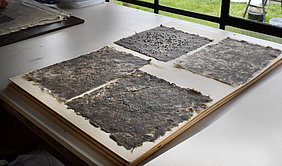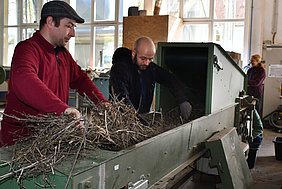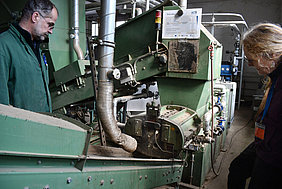Hemp, a domestic plant in Germany that still does not receive enough attention, even though there are vast possibilities for its usage as a versatile resource. However, three artists took on the challenge of using hemp instead of common resources to scoop paper. Was the project a success? Is hemp a suitable resource for the production of paper?
by Marie Christin Mark, trainee
In the beginning of May, three artists visited us at ATB and brought dry hemp straw bunches, including the remaining raw fiber material from their summer project, along with them. They struggled with breaking the hemp and debarking it and asked Dr. Hans-Jörg Gusovius, leader of the ATB working group ‘Process engineering for fibre plants’, for support. With our many years of expertise and our pilot unit for fiber plants, we were able to cut the hemp into fiber straw with the guillotine and then shred the fiber straw with the extruder into a very fine fiber material.
An issue arose during the further processing, as wood resp. shive content were still present. The first scooping efforts did not turn out as expected, as they were brittle and crispbread-like. This may be suitable for things such as packages, but not for the manufacturing of fine paper. At the Paho-Workshop in Großderschau, with the support of bookbinder and papermaker Janet Sifft from Berlin, the three artists continued their project. They cooked the extruded material from ATB, manually debarked the only guillotined raw fiber material, and cut the long hemp fibers (previously cooked) by hand. Now they further broke down the fibers and grinded the pulp to the desired grade. Finally, they were able to scoop delicate, translucent, and flexible papers, which they could rubberize on wool felts, drain, and dry in an impact press.
They displayed their results along with other art pieces on the "Day of the Open Studios" on May 6–7.
We at ATB are delighted that hemp as a material is gaining more attention once again. The artists did a terrific job demonstrating how much work goes into a project like this and all that you need to consider when using alternative resources like hemp. It truly is impressive how much effort they put into the project.
Now one question remains unanswered. Could hemp become a promising resource for producing paper and other versatile products on a wider scale?
Hemp offers huge potential since it provides strong fibers as well as a woody core. Beside the use of fiber for e.g. paper building materials and textiles, the woody part can be used as suagable litter for animals and building materials as well. The artistic project shows impressively which specific challenges we need to conquer to obtain an economic and practical process. At ATB we find solutions to harvest hemp and separate the fibers from the wooden core to acquire valuable natural materials as feedstock for further processing. Hemp definitely is a sustainable resource since it is a domestic plant and can grow in dry areas and therefore adapt to ever-changing climate conditions well. It does not need fertilizer and while growing, it sanitizes the soil for following crops.
Even in terms of recycling, hemp has an advantage compared to waste paper e.g., as it improves the recycling process thanks to the fact that we can reuse hemp up to 10 times. Climate wise, hemp is also more ecofriendly based on its CO2 neutrality (more or less) as we could source it regionally (no need to import pulp, etc.).
If you would like to read more on the project and the artists who are behind it, click here.
art project



